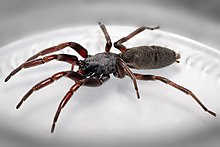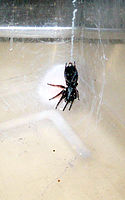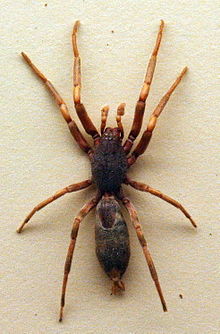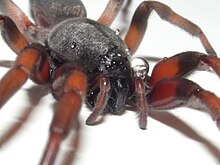| White-tailed spiders | |
|---|---|

| |
| Adult | |
| Scientific classification | |
| Domain: | Eukaryota |
| Kingdom: | Animalia |
| Phylum: | Arthropoda |
| Subphylum: | Chelicerata |
| Class: | Arachnida |
| Order: | Araneae |
| Infraorder: | Araneomorphae |
| Family: | Lamponidae |
| Genus: | Lampona |
| Informal group: | White-tailed spiders |
| Species | |
| |

White-tailed spiders are spiders native to southern and eastern Australia, and so named because of the whitish tips at the end of their abdomens. The body size is up to 18 mm, with a leg-span of 28 mm. Common species are Lampona cylindrata and Lampona murina. Both these species have been introduced into New Zealand.
White-tailed spiders are vagrant hunters that seek out and envenom prey rather than spinning a web to capture it; their preferred prey is other spiders.
They are reported to bite humans, with effects including a red mark, and local itchiness, swelling and pain. On rare occasions, bites can cause nausea, vomiting, malaise or headache. Although ulcers and necrosis have been attributed to the bites, a scientific study by Isbister and Gray (2003) showed they had other causes, mostly infections. A study of 130 white-tailed spider bites found no necrotic ulcers or confirmed infections.
Taxonomy
Ludwig Carl Christian Koch described Lampona cylindrata in 1866 and Lampona murina in 1873. The genus name comes from the Latin lampo ("to shine"). The species name cylindrata refers to the cylindric body shape, while murinus means "mouse-gray" in Latin.
Description



The two common species of white-tailed spiders are Lampona cylindrata and Lampona murina. They are similar in appearance; L. cylindrata is slightly larger with females being up to 18 mm long while males are up to 12 mm in body length. The legs span approximately 28 mm. The two species are not easily distinguished without microscopic examination. They are slender spiders with dark reddish to grey, cigar-shaped body and dark orange-brown banded legs. The grey abdomen has two pairs of faint white spots and—usually but not always—a distinct white spot at the tip just above the spinnerets.
The similarities have led people to think there is only one species of white-tailed spider. It is possible that not all white-tailed species have been identified. The descriptor, white tail, is applied to a variety of species of spiders for which a distal white mark on their abdomen is a distinctive feature; other markings disappear with moultings but the white tail remains to adulthood.
L. cylindrata lay pinkish eggs which are enclosed in a flattened silk capsule and are guarded by the female until they hatch.
Distribution
Both species are native to Australia. Lampona cylindrata is present across south-east Queensland, New South Wales, Victoria, South Australia, Tasmania and Western Australia while Lampona murina is found in eastern Australia from north-east Queensland to Victoria. The spiders have been introduced in New Zealand with Lampona murina residing in the North Island for over a hundred years while Lampona cylindrata has become widespread throughout the North and South Islands since 1980.
Habitat and behaviour
They live in gardens and inside houses, beneath bark and rocks, in leaf litter and are often found in the folds of clothes, towels and shoes. They do not build webs. Most active at night, they hunt for other spiders. Their favoured prey is the black house spider (Badumna insignis) and the closely related brown house spider (Badumna longinqua), both of which, like the whitetail, are native to Australia but have been inadvertently introduced to New Zealand.
Bites to humans
| This section needs additional citations for verification. Please help improve this article by adding citations to reliable sources in this section. Unsourced material may be challenged and removed. Find sources: "White-tailed spider" – news · newspapers · books · scholar · JSTOR (February 2021) (Learn how and when to remove this message) |
A common perception is that white-tailed spider bites can be associated with long term skin infections, and in rarer cases progression to necrosis. This is an attribution of infections presenting to medical care with a complaint of "spider bite." Venom has no bacteria, and infections do not arise from spider bites. The well-described brown recluse bite causes direct damage to skin and tissue. It has a limited area and does not spread. No formal studies have found evidence for associating necrosis with White-tailed spider bites.
White-tailed spider bites may cause a small red or discoloured bump, similar to an insect bite, that burns or itches.
The issue of necrosis in some bite cases in published studies begins with a paper presented at the International Society on Toxinology World Congress held in Brisbane in 1982. Both the White-tailed spider and the wolf spider were considered as candidates for possibly causing suspected spider bite necrosis in Australia. In Brazil the recluse spider was identified as linked to necrosis.
Following this initial report, numerous other cases implicated white-tailed spiders in causing necrotic ulcers. All of these cases lacked a positively identified spider — or even a spider bite in some cases. Additionally, there had not been a case of arachnogenic necrosis reported in the two hundred years of European colonisation before these cases. Of the 130 cases of White-tailed spider bites studied by Isbister and Gray, more than 60% reported that the person had been bitten by spiders that had got into clothing, towels or beds.
Clinical toxicologist Geoffrey Isbister studied 130 cases of arachnologist-identified white-tailed spider bites, and found no necrosis or confirmed infections, concluding that such outcomes are very unlikely for a white-tailed spider bite. The major effects from a bite in this study were local (pain, a red mark, local swelling and itchiness); and rarely systemic (nausea, vomiting, malaise or headache). All these symptoms are generally mild and resolve over time.
References
- ^ Slaughter RJ, Beasley DM, Lambie BS, Schep LJ (2009). "New Zealand's venomous creatures". N. Z. Med. J. 122 (1290): 83–97. PMID 19319171.
- ^ Isbister GK, Gray MR (2003). "White-tail spider bite: a prospective study of 130 definite bites by Lampona species". Med. J. Aust. 179 (4): 199–202. doi:10.5694/j.1326-5377.2003.tb05499.x. PMID 12914510.
- Gray, Mike. "Lampona cylindrata (Family Lamponidae) White-tailed Spider". Australian Government: The Department of the Environment, Water, Heritage and the Arts. Retrieved 14 June 2008.
- ^ "White-tailed spiders". Australian Museum. 2003. Retrieved 10 February 2008.
- Platnick NI (2000). "A relimitation and revision of the Australasian ground spider family Lamponidae (Araneae: Gnaphosoidea)". Bull Am Mus Nat Hist. 245: 1–328. CiteSeerX 10.1.1.694.2875. doi:10.1206/0003-0090(2000)245<0001:ARAROT>2.0.CO;2.
- "Spiders in New Zealand". New Zealand National Poison Centre. 2008. Retrieved 10 February 2008.
- ^ "White-tailed spiders (Lampona cylindrata and Lampona murina)". Museum of New Zealand Te Papa Tongarewa. Retrieved 4 April 2009.
- "White tailed spider: Lampona cylindrata". Museum Victoria. Archived from the original on 1 August 2008. Retrieved 3 April 2009.
- Forster, Ray; Forster, Lyn (1999). Spiders of New Zealand and Their Worldwide Kin. Dunedin: University Of Otago Press. pp. 111–2. ISBN 978-1-877133-79-4.
- "T.E.R:R.A.I.N - Taranaki Educational Resource: Research, Analysis and Information Network - House spider (Grey) Badumna longinqua".
- Gray M (July 1989). "A significant illness that was produced by the White-tailed spider, Lampona cylindrata". Medical Journal of Australia. 151 (2): 114–6. doi:10.5694/j.1326-5377.1989.tb101182.x. PMID 2739605.
- St George I, Forster L (May 1991). "Skin necrosis after white-tailed spider bite?". New Zealand Medical Journal. 104 (912): 207–8. PMID 2052219.
- Skinner MW, Butler CS (April 1995). "Necrotising arachnidism treated with hyperbaric oxygen". Medical Journal of Australia. 162 (7): 372–3. doi:10.5694/j.1326-5377.1995.tb139942.x. PMID 7715520.
- Chan SW (1998). "Recurrent necrotising arachnidism". Medical Journal of Australia. 169 (11–12): 642–3. doi:10.5694/j.1326-5377.1998.tb123446.x. PMID 9887918.
Further reading
- White, Julian (2003). "Debunking spider bite myths". The Medical Journal of Australia. 179 (4): 180–181. doi:10.5694/j.1326-5377.2003.tb05493.x. ISSN 1326-5377. PMID 12914504.
External links
- White-tailed spiders at the Australian Museum
- White-tailed spiders at Landcare Research, New Zealand
| Taxon identifiers | |
|---|---|
| Lampona murina | |